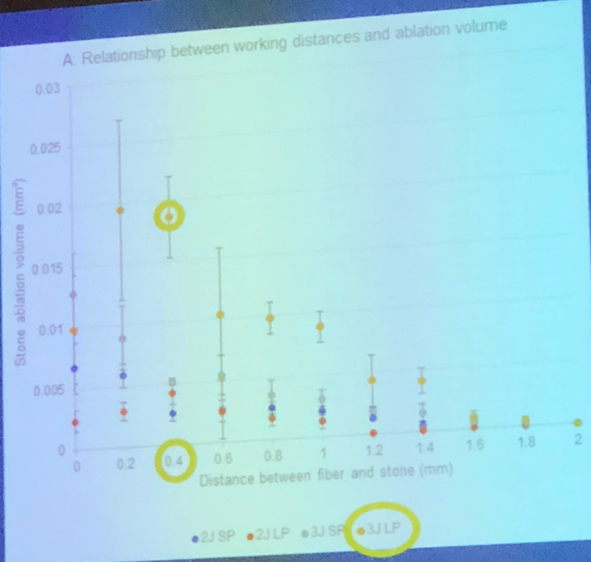So, at several different distances, they used two different pulse energies and two different pulse durations and recorded their findings. As a secondary objective, they looked at the vapor bubble and its effect on lithotripsy. They accomplished this by using a wave form generator that was able to deliver several pulses to the holmium laser machine. The laser fiber was fixed to an artificial stone in a bag filled with saline. For their secondary objective, they connected the wave form generator to a high speed camera, to evaluate the influence of the vapor bubble on ablation volume. Every pulse created a crater and volume of crater was calculated with image processing software.
At 3 J and long pulse mode, they found that at these settings they had the highest ablation volume in non-contact mode at 0.4 mm distance. At lower energy settings (2J), ablation volume was equal for short pulse and long pulse at a distance of 0.4 mm. When looking at long pulses, when they change the distance from contact mode to a 0.4 mm distance, the ablation volume increased by more than 80%. This was not seen for the short pulses. For the secondary objective, they evaluated the vapor bubble; and, in non-contact mode, the vapor bubble of the long pulse mode had a different shape that was small and short. It also had a chaotic multiple bubble stream, which was not seen in short pulse mode.

Dr. De Coninck found that 0.4 mm distance between laser fiber tip and stone surface with high energy and long pulses was the best working distance where they found the highest efficiency of ablation. The value of laser lithotripsy in non-contact mode may be explained by the chaotic multiple bubble stream seen from long pulses according to the presenter. Before concluding one member from the audience questioned whether the size of the laser fiber affected any results. Dr. De Coninck responded that they did not evaluate the size of the fibers but thought that smaller fibers may be ideal due to the fact of better irrigation and easier flexing of the ureteroscope. He then concluded that in the future it may be necessary to not just look at pulse duration, energy, and frequency to improve lithotripsy, but also may have to consider distance.
Presented by: Vincent De Coninck, MD, Urologist, AZ Klina, Brasschaat, Antwerpen, Belgium
Co-Authors: Etienne Keller, Fellow of the ES, Paul Chiron, MD, FEBU, Laurian Dragos, Consultant Urologist, University of Medicine and Pharmacy Victor Babes, Timisoara, Romania, Timisoara, Timis, Romania, Steeve Doizi, Urologist, Sorbonne Université, Laurent Berthe, Paris, Ile-de-France, France, Professor Olivier Traxer
Author Affiliation: Sorbonne Universite, Paris, France
Written by: John Sung, @JohnM_Sung, Department of Urology, University of California-Irvine, medical writer for UroToday.com at the 36th World Congress of Endourology (WCE) and SWL - September 20-23, 2018 Paris, France


